Hue. The Forbidden City Tour. Royal Court Music
After going to the back of Thai Hoa Palace (Palace of Harmony), I saw a model. This is a small model depicting the imperial city of Hue when it was full of architecture. However, most of these buildings are now gone as they were destroyed during the Battle of Hue. If you notice the green part is lost and the red part is present.
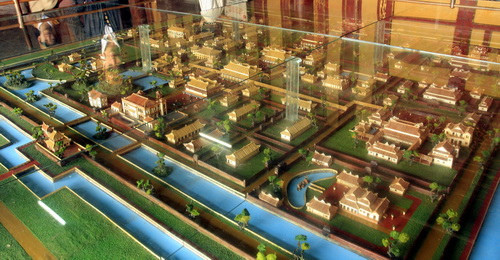
The small model of Hue
For the model, I can inform you that the citadel of Hue is a system of citadels with three rings :
- The outer ring has around 6 meters high walls with 10 gates
- The second ring is called the citadel just about 4 meters high with 4 gates that we have visited . One gate is Ngo Mon Gate or Summer Gate.
- The third ring is the Forbidden City
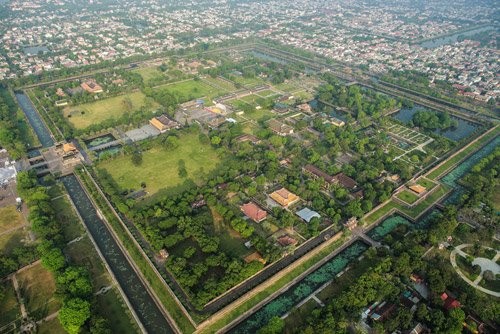
The imperial city looked at from the sky
Where do you think we are now?
Yes, we are standing in the Citadel, behind Thai Hoa Palace.
You can see that immediately after Thai Hoa Palace is the Forbidden City - the area has a green border. This is the place where they eat at the Royal Living. Inside the Forbidden City, there are about 40 structures of different sizes and designs, divided into many areas. However, I am sad to say that most of these relics are gone. Along the north-south axis, there is electricity in the Forbidden City: Can Chanh is the place where the king works every day and where he sleeps. Khon Thai is the residence of Hoang Quy Phi's wife.
In addition, I will introduce two more beautiful constructions, which are the Royal Theater of Duyet Thi Duong - the theater for the king and Phu Van Lau and the Peace Library House where the king spends his free time reading books.
After that, the tour guide called us to the back yard of Thai Hoa Palace to explain the Forbidden City. At this point, people were absorbed in watching the full model of the city and forgot to see the real works.
The Forbidden City has 7 gates. The south gate is the only one that goes through the Thai Hoa Palace, the Grand Palace.
Tour guides said that this 5-room wooden building was made in the reign of King Minh Mang. The door is very large and made out of gold wood lacquer, and carved sophisticatedly.

The red carpet frontage that we are seeing is the location of Can Chanh Palace - a wooden structure near the Thai Hoa power headquarter.
Unfortunately, it is sad that a beautiful palace and also the most important palace of the Forbidden City was demolished by the communist army and the bombing of US aircrafts.
If you play Call of Duty like me, I bet you will know the Battle of Hue
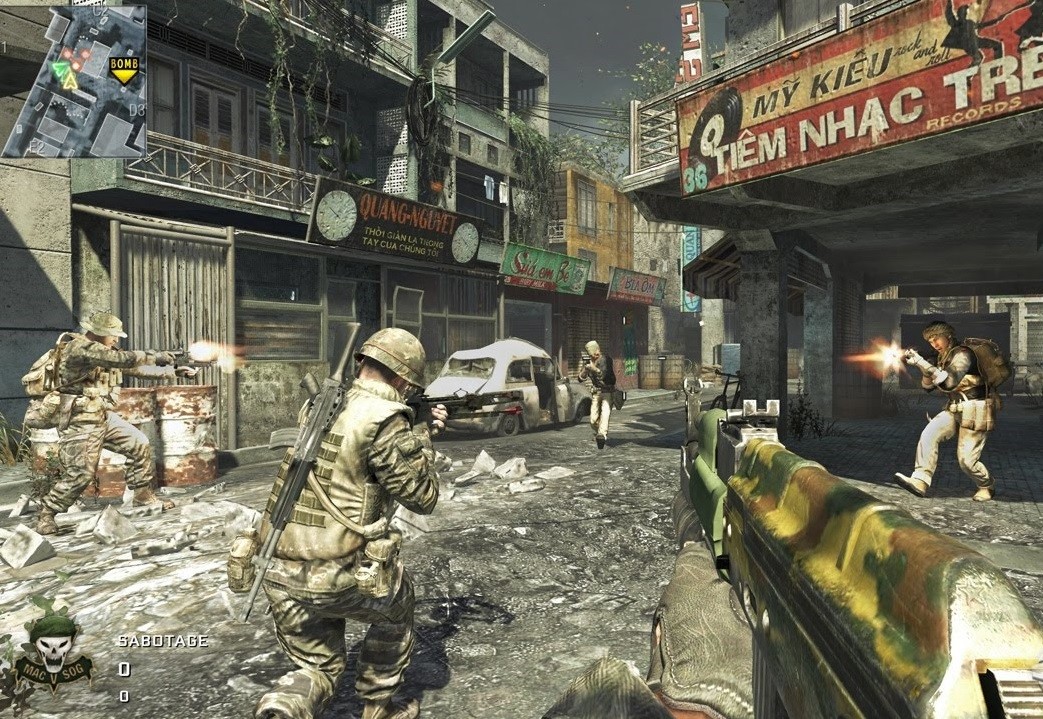
The battle of Hue in Call of Duty
Besides Can Chanh palace, we have visited two of the few remaining works of Forbidden City that are Ta Vu and Huu Vu. These are two buildings where rulers were prepared before the tide: Ta Vu is the building for the literature Mandarins on the right and Huu Vu is the building for the martial arts Mandarins on the left.
I went to the building on the right; now inside them they display some precious relics from the Nguyen dynasty.
This is a 10 kg gold seal from the time of King Ham Nghi. If you notice, you will see a golden dragon that is the symbol of the king.
Also in Huu Vu, I saw a photo shoot service: you can wear royal clothes to take pictures, although I personally do not like it very much. These costumes are cheap, not court clothes. If I wore them, I'd probably be called Fake King.
1. Duyet Thi Duong Theater
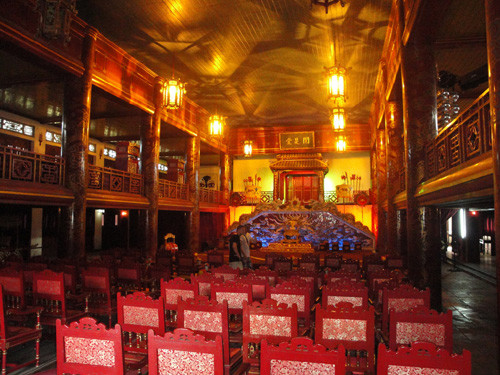
Next, we went to Duyet Thi Duong Theater, a royal theater.
Duyet Thi Duong is a theater in the imperial palace of the Nguyen Dynasty. This is a large-scale theater, built earlier than other theaters in Hue.
I personally find it as wide as the small theater in the royal palace in Vienna.
However, it is not used for piano recitals or European classical music, but to represent theatrical arts that are mainly performed in Chinese theatre, in order to serve the king, the entire royal family, the royal court and foreign guests who have relations with the court. I looked closely at the stage with three parts, the wall at the bottom of the stage with two doors and the actors on the right and left. Behind the wall is a large room containing cabinets for chapters, crowns and performance props. In the room there is also a worship of the singing professors.
Anyway, as far as I know, Duyen Thi Duong Street has undergone many repairs and design changes. Today's theater is rebuilt on the old ground of the old theater because the ancient theater was completely destroyed in 1962 by the US bombing.
At a glance, I saw the rectangular theater, curved roofs like the roof of the pagoda is backed by some columns of lacquer. The theater was built at the back of the palace where there the king and her ladies were. Viewers sitting on a high platform occupy most of the theater. In front of the audience stands a curtain.
I was impressed by the harmonious decor of the theater: the Vietnamese dragon was displayed all over the wooden frames, or clustered around the trunk. The ceiling is painted blue, the stars with the signs of the palace above. Furniture installation is very adequate.
I felt like the stage really did not exist, there was no separation between the real world and the actors. The actors synchronized with the audience in a large square frame, held right in front of the throne and reserved for Mandarins. Decoration: a wall with two doors to the left, go to the right. Such a stage is admired by viewers in the art world.
Unfortunately, in 1962, Duyet Thi Duong Theater was used as the Hue National Music School. The interior of the Duy Nhat has therefore been also renovated to accommodate the teaching and learning of the school.
Although Duyet Thi Duong Theater is no longer the same, I find it still has certain historical values that help me to understand some aspects of the entertainment life of ancient kings.
Then we continue the journey to explore the Forbidden City, and the next place is Thai Binh Lau
- 2. Thai Binh Lau (Peace Library House)
Thai Binh Lau is a unique architecture of the Forbidden City of Hue.
This is the place for the Nguyen kings to read the books.
Even so, I felt it was a bit small, perhaps because only the king came here to read books so the building was not built to accommodate many people.
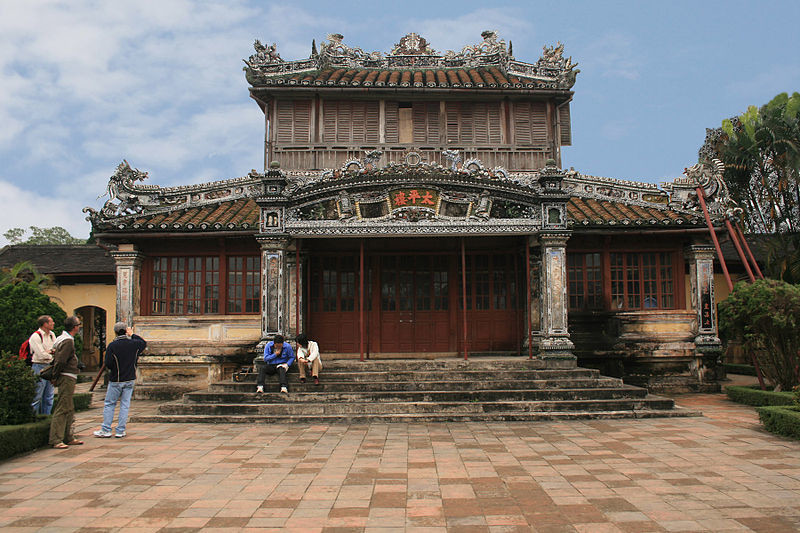
We stopped at Thai Binh Lau just 15 minutes and continued the journey.
Perhaps you do not know, the Nguyen dynasty kings are very fond of Confucianism. According to this, death is not the end but the continuation of another life and their existence is the worship of children. This is the custom of worshiping ancestors of thousands of Vietnamese ancestors. That is the main reason for building a giant temple called The Mieu.
- 3. The Mieu Temple
This is the middle of the Temple:
From outside

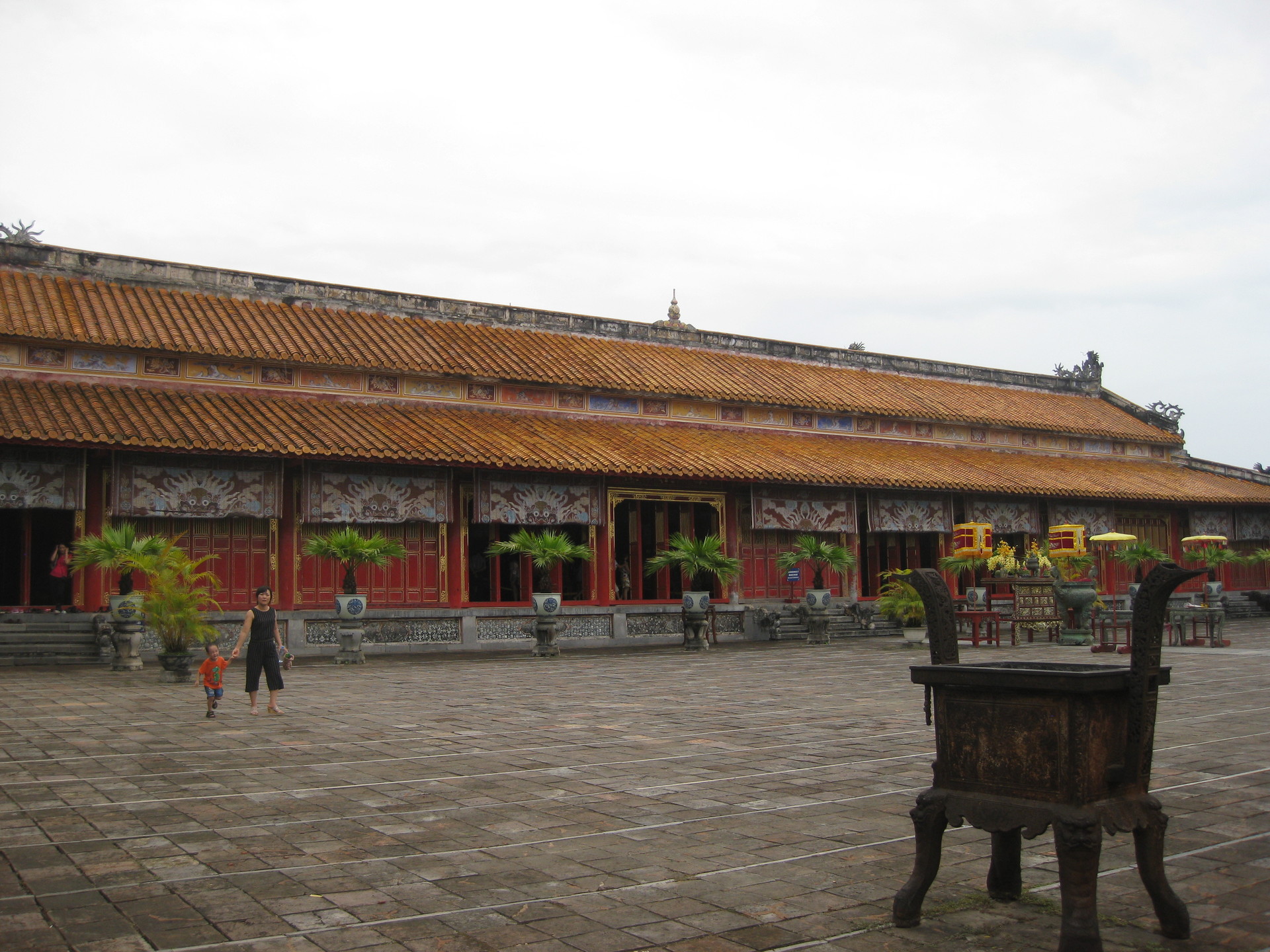
The inside:

The shrine is located on a rectangular campus. The main building has 10 chambers, each one dedicated to a king. There are 10 Nguyen Kings being worshiped here:
I was standing in the central (middle): worshiping King Gia Long, the first king of Nguyen Dynasty. On the right hand side is the grave of King Minh Mang's son and on the left is King Thieu Tri Minh Mang, grandson of Gia Long. Nguyen Kings had many wives, like Minh Mang with 500 wives and 142 children, of which Thieu Tri was the eldest. Therefore, only the queen of the king is worshiped in the shrine.
Previously, according to the Nguyen family, only kings who died in their place were to be worshiped in the shrine, while kings were considered as "deposed" then they would not be worshiped in this shrine. Therefore, before 1958, within the Toh Mieu Temple there were only seven churches: Gia Long, Minh Mang, Thieu Tri, Tu Duc, Kien Phuc, Dong Khanh and Khai Dinh. And in October 1958, the worship of three patriotic kings Ham Nghi, Thanh Thai and Duy Tan, who were classified as "emperor", were also worshiped at the shrine.
The monuments of King Duc, Hiep Hoa and Bao Dai, which are the kings in the history of Vietnam that have stated that they cooperated with the French to exploit the people, are not worshiped in the present in this temple.
I hope a day when the Vietnamese have a more open-minded view, the government will not ban it anymore.
- 4. Hien Lam Pavilion
Then we continue to visit Hien Lam Pavilion, which is the tallest building in the forbidden city.
I first saw Nine Tripod Cauldrons in front of the building.
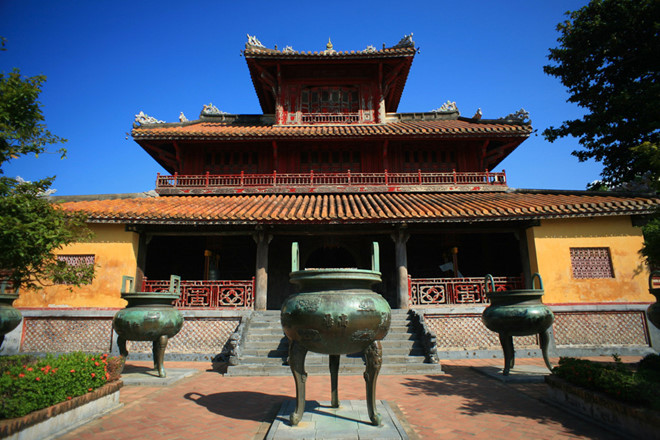
Nine Tripod Cauldrons are the Nine Largest Bronze Tripod Cauldrons in Vietnam. They were casted in Minh Mang. Nine summits are used as a symbol of the country's beautiful, united and long-lasting dynastic dream.
When I first looked at the 9 Tripod Cauldrons, I thought they were the same, but in fact after looking closely, I found that they were different: different in weight to feet, as well as set of each one. But the most distinctive difference I found was that 17 images touched each tripod cauldrons. The seventeen relief images surrounding each peak include what Vietnam represents from Lang Son Province to the tip of Ca Mau Province and is referred to in the following subjects: stars, rivers, mountains, seas, boats, vehicles, precious commodities in the forest, under the sea of Vietnam in the past.
As far as I've heard, the Hien Lam Pavilion is considered as a memorial to the generals who died for the Nguyen Dynasty. Hien Lam The is built in front of the shrine, on a rectangular high block, paved with Bat Trang tiles. From the bottom of the platform to the two levels of the Qing stone system, before and after each system has 9 ranks. The two sides of the level of the dragon in the middle is limited to the path reserved for the king.
Anyway, I like the embossed stylized dragon motives that turn into leafy vines. On the middle door hung a large horizontal lattice with three words "Hien Lam".
- 5. Nha Nhạc - Hue Royal Music - intangible cultural heritage of mankind
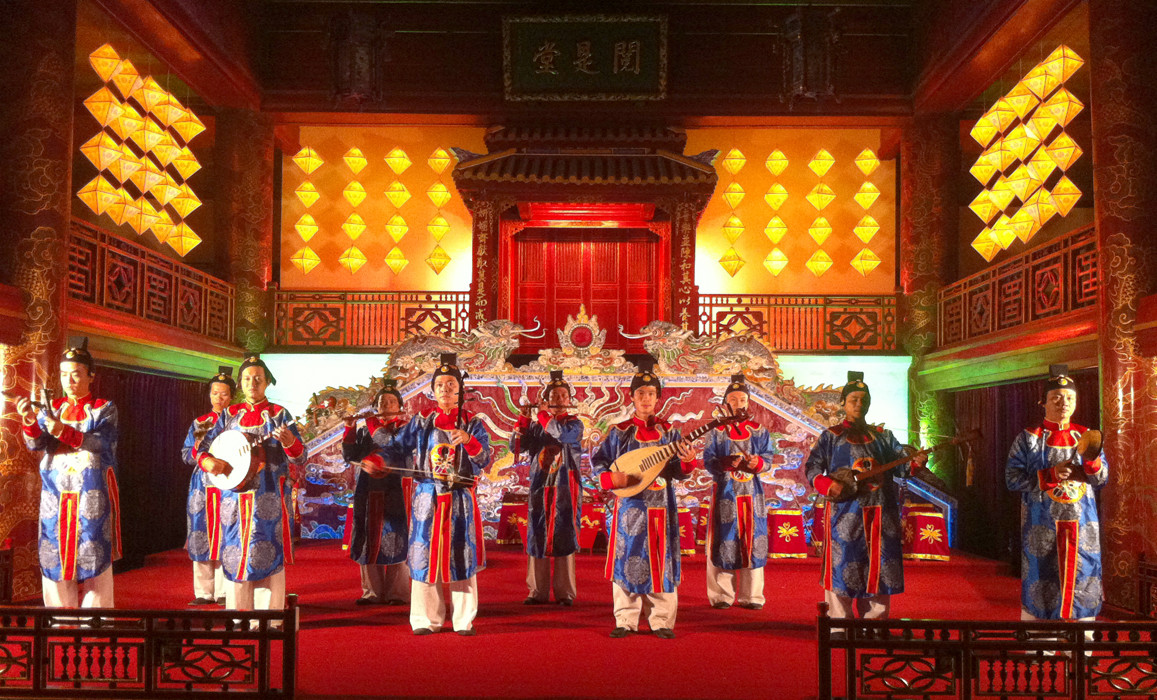
First of all, I would like to recommend this asa kind of music of the monarchical dynasties in Vietnamese society. You simply think if we now listen to pop music or rock or anything else, Nguyen Kings also have their own music to match up with them. Therefore, Nhã Nhạc aims to create the solemnity of the royal ceremonies. So this essence was condensed under the Nguyen Dynasty, making Hue more assertive about a typical cultural center of the nation. With all that historical value, Hue royal court music has been listed on UNESCO List of Oral and Intangible Masterpieces of Humanity.
Because of this, I am more proud of Hue, in parallel with the two world cultural heritages: material and non-material. It marks a turning point in the cultural world of this city.
While the material heritage is the ancient city itself, non-material heritage is what we are discussing.
According to historical itinerary, I know that in the past, Nha nhac (Royal Court Music) is the mainstream music, which is considered as the national music, used in feasts and international feasts of the court. The kings paid great attention to the development of royal music, and this type of music became a symbol of kingship for the prosperity of the dynasty. The regulations on orchestra scale, the way of performance, the content of the music... are very strict, reflecting the nature of the regulation through a very high aesthetic institutions capable of reflecting thought and the philosophy of the contemporary monarchy.
According to the history books, Nhã Nhạc was born in the Ly dynasty 1000 years ago. I can not believe that 1000 years ago we had a harmonious band of music. Moreover, I found the band's activity very organized and well-prepared as if you do not make it perfect, you will be beheaded. Music organizations are established, under the control of the music.
However, I must say that Nha Nhac has met many challenges in Vietnamese history, one of which is the Civil Vietnam War, in the 14th and 18th centuries.
At the end of the nineteenth century, when Vietnam became a French colony, the role of the court faded, court music and rituals also decreased and faded. In addition, the court introduced Western orchestras, making the role of ancient music more blurred.
However, I feel fortunate that today, thanks to the help of the donor, the Vietnamese government is trying its best to restore the royal court music, rather than the usual royal music.
That day we went to the concert tickets office, but they were out of ticket so we did not listen to royal music at Duyet Thi Duong theater, instead we went to listen to it on the Perfume River that night.
Anyway, I found it to be a great experience, just as I was going to listen to the flamenco show in Spain, and listen to Fado music in Lisboa.
Photo gallery
Content available in other languages
Want to have your own Erasmus blog?
If you are experiencing living abroad, you're an avid traveller or want to promote the city where you live... create your own blog and share your adventures!
I want to create my Erasmus blog! →

























Comments (0 comments)